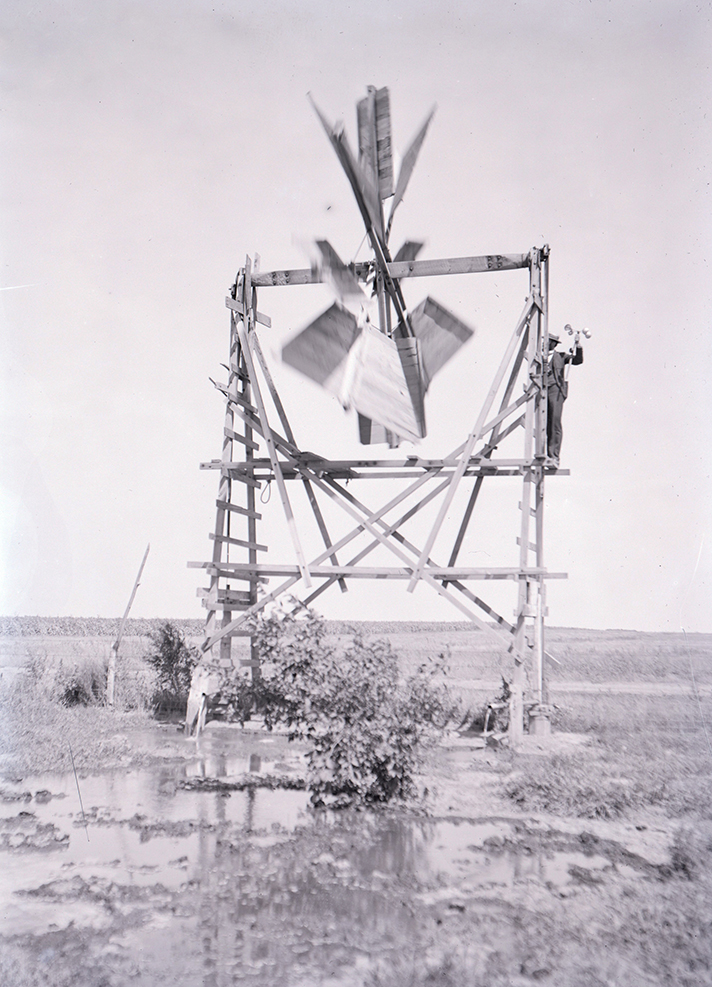
In one black and white photo a family of nine, from infant to elder, sit around a hole dug in the earth, a giant mammoth tusk half excavated. In dresses and suits, hats perched upon their heads, the group looks directly into the camera that snaps the photo.
In another, a man stands on the framework of a large, rectangular windmill, an anemometer in his hand as he measures the windspeed and efficiency of power generated.
It was 1898, and the man taking the photo, the man measuring the wind, was E. H. Barbour, head of the Department of Geology, director of the State Museum and director of the Nebraska Geological Survey at University of Nebraska. The state survey organization now is known as the Conservation and Survey Division in the School the Natural Resources.
Barbour took thousands of photographs during his career at the university, and through August 10, about 40 of them will be on display as part of the exhibition “Lost World of E. H. Barbour: Renaissance Man on the Plains” in the second-floor lobby of Love Library South, 1248 R St. (For library hours, visit http://libraries.unl.edu/love-library.)
“The intensity of his absorption in his work and depth of his curiosity of the natural world showed through patently in his photographs,” said Matt Joeckel, associate director of for the Conservation and Survey Division and co-creator of the exhibit with Mary Ellen Ducey, University Archives special collections librarian, and Traci Robison, University Libraries photograph and exhibits specialist.
“This exhibit is giving the public a small glimpse of his world, but it’s bigger than this small group of photographs indicates,” he said.
Though others had acted in some capacity as state geologists before him, Barbour was the first to take a deep and systematic approach to geology and paleontology in the state, Joeckel said. Part of that was his emphasis on recording and documenting discoveries across the state.
His interests were widely varied: paleontology, geology, earth sciences, construction, civic improvements, windmills. Also photography, art and growing prize-winning irises.
“He was a Renaissance man, maybe the last of them,” said George Corner, Nebraska State Museum collections manager who played an integral role in informing the exhibit.
And Barbour cultivated those interests for decades.
“They really must have sustained him,” Joeckel said. “He never became detached from his interest in the world around him. He was a multi-interested man, to the university, the community and the thousands and thousands of Nebraskans around him.”
From the moment he arrived on campus in 1891, Joeckel said, Barbour got involved and built lasting relationships with the people around him.
The one Barbour built with Charles Morrill is the reason Nebraska has a state museum, Corner said.
“Without the other, each one separately, it wouldn’t have been done,” he said. “With the two of them, they did it.”
Barbour served as director of the state museum for 50 years, and for 30 of them, he also was serving as a department head. At the same time, he served as chairman of the Lincoln School Board where he played in instrumental role in getting the present Lincoln High School built, and he also served on the Wyuka Cemetery board, where he helped design and develop the space.
“He was serious about community involvements,” Corner said. “Anything they asked him to do, he gave it his all. He served on a lot of committees on campus and in the community.”
A tentative plan is in the works to create a second Barbour display for the State Museum at Morrill Hall as part of the museum’s 90th anniversary in 2017. That show would highlight more of Barbour’s work in relation to creating and sustaining the museum.
“We hope this show piques people’s curiosity to see more,” Ducey said. “This exhibit has barely touched the surface. There is so much more for people to discover.”
That’s how science works
Barbour’s life included personal challenges and making scientific mistakes – in publications and in science, Joeckel said.
“Today [scientists] we think we need to be correct all the time, but that is not so,” he said. “It’s very important to remember that.”
One of Barbour’s biggest mistakes was his interpretation of the Daemonelix, a trace fossil found across Nebraska that has a corkscrew shape.
“They are among the most spectacular trace fossils ever discovered,” Joeckel said. Some have been as large as 8-foot high. “Barbour was obsessed with the Miocene era fossil; he spent a lot of time interpreting them, wracking his brain” to interpret what they were or how they were created.
He hypothesized that Daemonelix fossils were the result of calcified plants. But in the end, his interpretation was incorrect; prehistoric beavers were responsible for creating the corkscrew burrows.
“But that’s science,” Joeckel said. “That’s how science works. He bounced back and went on; he did the best he could with the information he had at the time.”
-Shawna Richter-Ryerson, Natural Resources
More details at: http://go.unl.edu/jcoj